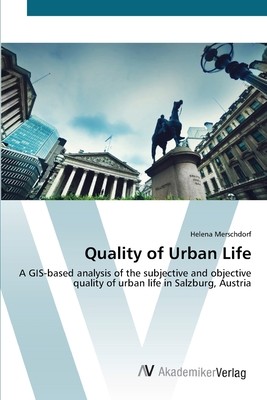
- We will send in 10–14 business days.
- Author: Helena Merschdorf
- Publisher: AV Akademikerverlag
- Year: 2014
- Pages: 124
- ISBN-10: 3639720113
- ISBN-13: 9783639720112
- Format: 15.2 x 22.9 x 0.7 cm, minkšti viršeliai
- Language: English
- SAVE -10% with code: EXTRA
Reviews
Description
This research examines the case study area of Salzburg, Austria in terms of its Quality of Urban Life for two dimensions, namely the objective dimension and the subjective dimension. The subjective dimension is analysed based on N=802 interviews conducted with the local citizens all over the city, while the objective data comprises coverage data and point data indicating facilities. Initially, five quality of life indicators of both the objective and subjective dimension are chosen and spatially mapped to 250m raster cells. These indicators are 'Green Spaces', 'Housing Satisfaction', 'Proximity to Public Facilities', 'Proximity to Educational Establishments' and 'Proximity to Public Transport Stops'. Subsequently the AHP method is utilized to derive weights for each indicator and produce overall quality of life maps for both dimensions, in order to answer the research question 'do the objective quality of life indicators significantly predict their subjective counterparts, and are the subjective perceptions in themselves coherent?'
EXTRA 10 % discount with code: EXTRA
The promotion ends in 22d.01:14:32
The discount code is valid when purchasing from 10 €. Discounts do not stack.
- Author: Helena Merschdorf
- Publisher: AV Akademikerverlag
- Year: 2014
- Pages: 124
- ISBN-10: 3639720113
- ISBN-13: 9783639720112
- Format: 15.2 x 22.9 x 0.7 cm, minkšti viršeliai
- Language: English English
This research examines the case study area of Salzburg, Austria in terms of its Quality of Urban Life for two dimensions, namely the objective dimension and the subjective dimension. The subjective dimension is analysed based on N=802 interviews conducted with the local citizens all over the city, while the objective data comprises coverage data and point data indicating facilities. Initially, five quality of life indicators of both the objective and subjective dimension are chosen and spatially mapped to 250m raster cells. These indicators are 'Green Spaces', 'Housing Satisfaction', 'Proximity to Public Facilities', 'Proximity to Educational Establishments' and 'Proximity to Public Transport Stops'. Subsequently the AHP method is utilized to derive weights for each indicator and produce overall quality of life maps for both dimensions, in order to answer the research question 'do the objective quality of life indicators significantly predict their subjective counterparts, and are the subjective perceptions in themselves coherent?'


Reviews